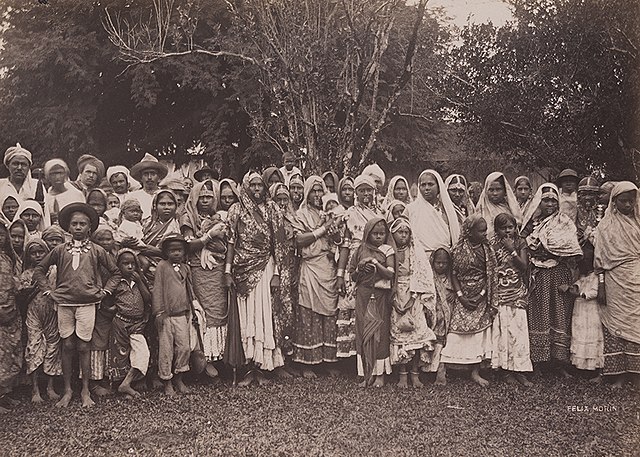In the aftermath to the abolition of slavery, about 2 million indentured workers travelled from the Indian sub-continent to the British plantation colonies between 1834 and the First World War. Unlike slavery, the indentured workers were contractually guaranteed a return trip to India at the end of their indenture period. However, only about a third of the workers took this return passage. What determined this decision to return? Using individual-level data on indentured workers collected from ship registers from Walter Rodney archives in Georgetown, Guyana, Neha Hui and Uma Kambhampati look at how social marginalisation based on caste and gender back in India played a role in this decision.

The caste structure in India is a system of social organisation in Hinduism. This system has historically been characterised by strict social hierarchy, privileging higher castes, and stigmatising lower castes. Caste hierarchy was maintained and perpetuated through rigid separation of castes and restrictions in intermarriage, cohabitation, and inter-dining between castes. The caste categories were based on occupation and were hereditary, with mobility between castes prohibited. Over centuries, this ossified into a rigid division of labour with individuals from the lowest castes being locked into manual, unskilled labour and excluded from mainstream educational institutions. Such hierarchical structures meant that historically individuals from lower caste backgrounds were deprived of ownership of productive resources and land. They often lived and worked under conditions of hereditary servitude and bondage to higher caste landowners.
While Hinduism continued to play an important role in the organisation of life in the plantation colonies, most of the prominent features of the caste system had to be dropped. All migrants to the plantation colonies were involved in similar, low-skilled work and the European work routine did not allow workers to conform to the traditional caste-based organisation of labour. In addition, physical segregation and isolation were not possible either on the journey across the seas nor on the plantations themselves. Traditional norms regarding physical segregation, restrictions on caste mobility and control of sexuality were not a part of the lives of migrants in the plantation colonies. All Indian emigrants, regardless of caste, were huddled together in shared accommodation and were forced to share food and intermix. While caste did not disappear in the plantation colonies, it was not useful for governance and therefore there was no reason to perpetuate it.
We look at the role of caste in the decision to return using data from ship registers for more than 16,000 Indian indentured workers in British Guiana between 1872 and 1911. We find that individuals from very low castes were significantly less likely to return home, because caste hierarchy played a very significant role in every aspect of the workers’ lives back in India, but not on the plantations. Low caste workers who stayed on in British Guiana were therefore able to escape the unfreedom of caste. We find that the association of ‘higher caste’ group and repatriation decisions is positive and significant, but the significance disappears when we include variables that are proxy for economic conditions, such as indicators of weather shocks affecting agricultural communities and district-specific agricultural tax regime. This implied that only higher caste individuals returned, and only when the economic conditions back at home were favourable. This is in part because high caste Hindus were restricted from travelling abroad and faced excommunication if they failed to comply. Famously, MK Gandhi was excommunicated following his return from the UK. However, during the British administration, foreign travel was reasonably frequent, and individuals could be recommunicated following a purification ceremony that included a payment of fees to administering Brahmins. The expense was exorbitant and would imply that regaining the position in the caste hierarchy was restricted to those who could afford it.
The return trends were also interesting for women. Women formed a minority of the workers who travelled to British Guiana. While some women had travelled with their husbands, many (about 63 per cent in our sample) travelled on their own. The literature suggests that these were widows, destitute and facing discriminatory gender norms in India. Indentured immigration may have been their way of escaping such gender norms. We find that across all caste groups women who travelled with their husbands were more likely to return in comparison those who travelled alone. For women who travelled alone, life in the colony entailed fewer social and religious restrictions.
We also find that for men the probability for returning is highest for high caste groups, followed by middle caste, followed by Dalit. For women, however, the difference between high caste groups and middle caste groups is not significant, and the difference with Dalit women was smaller than for men. This meant that people who had been on the top of the caste hierarchy before the migration, and who could afford to return to that position were more likely to return. For individuals who had ‘no caste to lose’ and for women, returning to India wasn’t so attractive.
Among the Indians who lived on in British Guiana after the indenture period, some continued to live and work in the plantations, but an increasing number went to live in village settlements and towns where they raised and educated their children. Currently about 40 per cent of the Guyanese population is of Indian descent and the descendants of migrants continue to play an important part in Guyanese politics and economics. Notably, the first chief minister, and later the first premier of British Guiana following the introduction of universal suffrage was Cheddi Jagan, a son of indentured workers.
Neha Hui is a development economist who won the University’s Research Output Prize for her article as lead author with Uma Kambhampati: ‘Between Unfreedoms: The role of caste in decision to return among indentured workers’, Economic History Review, Oct 2021.
